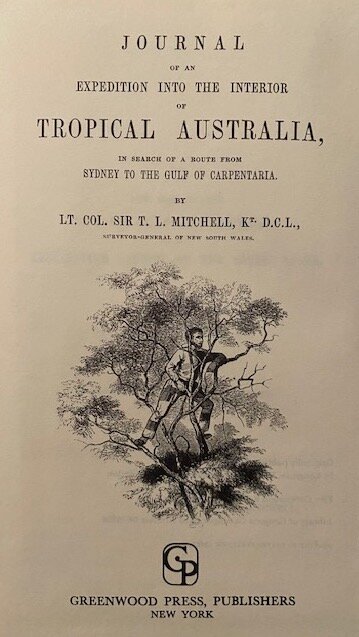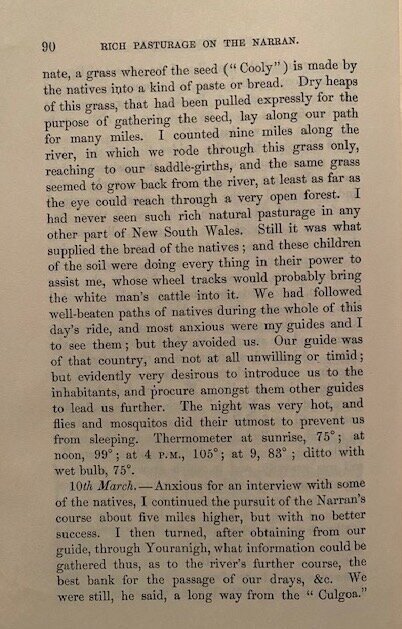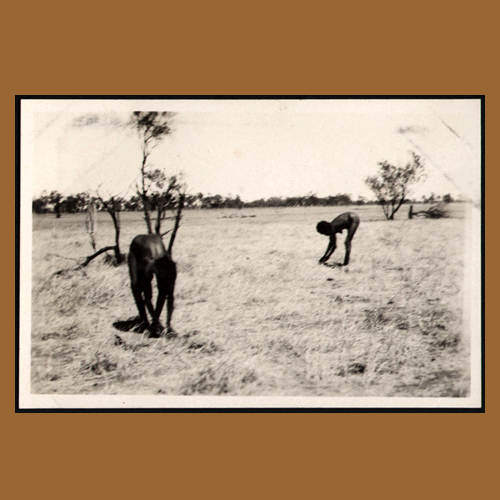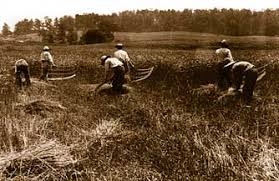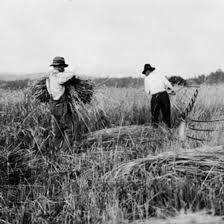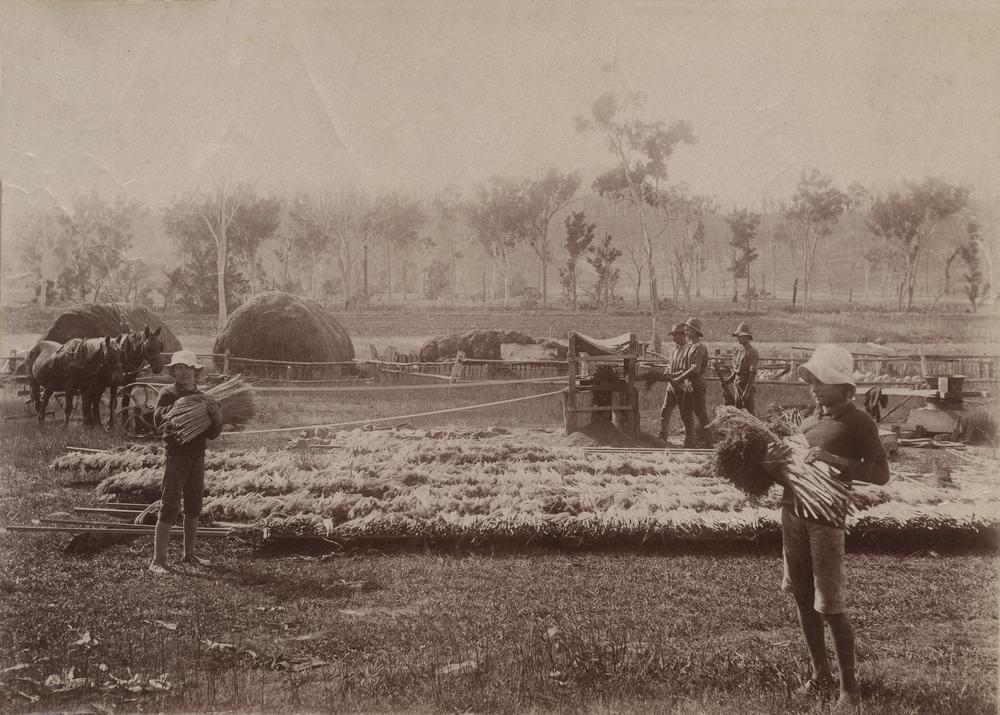Mr Pascoe is Full-Steam Ahead - No Stooking Here!
Mr Pascoe on frequent occasions in his lectures and interviews refers to the explorer Mitchell riding through “nine miles of stooked grain” (about 14kms), which gives the impression that Aboriginal agriculture was being undertaken on a vast scale, even bigger than modern, mechanised Australian farms where, for example, canola is typically cut and piled with $1M harvesters into swaths for drying in paddock lengths of say, up to 2 km. So, it does appear that some manipulation of Mitchell’s words may be occurring to make the reader believe that Aboriginal “farmers” using hand-held, stone-age tools, “did sow, irrigate and till the land” to produce 14km long fields of “stooked grain”.
“Nine miles of stooked grain” - Really?
In his 2014 Dark Emu book, Mr Pascoe writes :
‘As he [Mitchell] crosses the Australian frontier, he describes what he sees: “[T]he grass is pulled…and piled in hayricks, so that the aspect of the desert was softened into the agreeable semblance of a hay-field…we found the ricks or hay-cocks extended for miles.’“ - (Dark Emu, 2018 reprint, p15)
By the time of Mr Pascoe’s 2018 lecture below, Mitchell’s ‘facts’ had been stretched a bit further to include :
“In 2014, I [Pascoe] wrote a book, Dark Emu, which exploded the myth that Aboriginal people were mere hunters and gatherers and did nothing with the land. I wrote the book because I found it hard to convince Australians that Aboriginal people were farming. Using colonial journals, the sources Australians hold to be true, I was able to form a radically different view of Australian history. Aboriginal people were farming. There's no other conclusion to draw. Colonial explorer, Sir Thomas Mitchell, rode through nine miles of stooked grain. “ [our emphasis]
- Excerpt from a transcript of a Ted Talk June 2018 (Published July 25 2018), at time points 00:15 – 00:60. - here :
What Mitchell actually said in his 1848 Journal of an Expedition into the Interior of Tropical Australia, on page 90 (1969 reprint), was :
‘Dry heaps of this grass, that had been pulled expressly for the purpose of gathering the seed, lay along our path for many miles. I counted nine miles along the river, in which we rode through this grass only, reaching to our saddle-girths, and the same grass seemed to grow back from the river, at least as far as the eye could reach through a very open forest. I had never seen such rich natural pasturage in any other part of New South Wales.’
So, Mitchell records that he rode through nine miles of rich, natural pasturage (grass) standing up to his horse’s saddle-girth (that is, not fields of human cultivation, but just tall, wild grass fields), with some dry, pulled grass laying in heaps along the way; he did NOT appear to ride through a continuous “nine miles of stooked grain”.
Mr Pascoe also seems to incorrectly cite this in Dark Emu as being from Mitchell’s other cited journal, Three Expeditions into the Interior of Eastern Australia, when in fact we found it in Mitchell’s 1848, Journal of an Expedition into the Interior of Tropical Australia, on page 90 (1969 reprint).
Just to re-enforce how it appears that Mr Pascoe ‘just makes stuff up’, consider what he said during his Byron Writers Festival interview with Kerry O’Brien in 2019.
Pascoe tell O’Brien,
“I went to the first second hand book shop…and I came across Sir Thomas Mitchell’s Journals into Tropical Australia and I bought it…and I read it in the car, on page 90 it said that ‘Mitchell rode through nine miles of stooked grain’ and that word ‘stooked’ stood out because I’d never heard it in all my years of education referred to Aboriginal people. So there it was. “ - Recorded on Soundcloud at 5:50
Except, no it wasn’t. As evidence, see the photograph of the book page in question below - on page 90 there is no sign of the word ‘stooked’ and, in relation to ‘nine miles’, Mitchell only says,
‘I counted nine miles along the river, in which we rode through this grass only, reaching to our saddle-girths…’
If Mitchell had seen any sign of Aboriginal agriculture such as tilling the land, sowing seeds, cultivating, weeding or irrigating, it is most likely he would have recorded it. Instead, he just recorded that he saw grass pulled out and piled in heaps to dry. This is a classic hunter-gatherer seed collecting technique.
To harvest and stook 14 km fields of grain is a massive task, which would require hundreds of Aborigines either, pulling the grass by hand as the two women are doing in the image below or, at best, they would use an inefficient stone-knife to cut the stalks. Compare that to the teams of colonial harvesters using scythes and other equipment in the images below, who still would not have been able to “stook grain” for 14 kms.
As a final piece of real evidence, rather than just relying on Mr Pascoe’s interpretation of a few, Eurocentric farming words in an explorer’s journal, we have located a film clip of a family group of Aboriginal women, gathering wild grass-seeds in the central Australian region of Mr Pascoe’s “Aboriginal Grain Belt.” It shows the seed-grasses growing to a height of ‘saddle-girths… along a river‘ in a typical scene as described by Mitchell. We invite the reader to watch this wonderful film clip and immerse themselves in this 50,000 year-old scene of Aboriginal hunter-gatherers at work. We believe it is highly disrespectful of Mr Pascoe towards these women to portray them as soil-tilling farmers, which is clearly something that they are not.
Mr Pascoe claims he used as sources for Dark Emu, “…the journals and diaries of the explorers and colonists. These journals revealed a much more complicated Aboriginal economy than the primitive hunter-gatherer lifestyle we had been told was the simple lot of Australia’s First People.” - (Dark Emu 2018 reprint, p2).
It appears from our research of Mr Pascoe’s sources, that he is being very selective in what he quotes from the explorer’s journals. For example, as above when the explorer Mitchell uses words like, "ricks or hay-cocks“ , Mr Pascoe seizes on this as evidence of a scene of ‘Aboriginal agriculture’ that Mitchell was describing to his readers. However, Mr Pascoe does not attempt to address the contradictory evidence from many other explorers who describe the Aboriginal economy from areas similar to where Mitchell travelled. For example, the explorer Alfred Giles, while travelling through Mr Pascoe’s, “Aboriginal Grain Belt’ area of South Australia and the Northern Territory, recorded his observations thus:
“Just as we had passed through the gorge and were travelling over splendid grass flats we suddenly came upon an old and decrepit black lubra and several piccaninnies of various ages digging yams. The youngsters set up a terrible howling, but the old dame stood still and undecided what to do. She took care, however, to put the youngest child on her back, and made a few steps in the direction of the scrub, but again stopped, muttering, wringing her hands, and calling out to a younger lubra, who appeared from behind some trees. Mr. Ross got off his horse and walked towards them, making friendly signs, but this was too much, and they dashed off at once into the scrub. We picked up some of the roots, or yams, which were about nine inches long and as thick as a radish. We followed the creek three miles, and saw another lubra and three piccaninnies; but like the others, they vanished immediately. We kept on following the river for about 10 miles, and found plenty of water, …. and entered splendidly grassed country with flats…” - Giles, A., Exploring in the Seventies, Pub. Friends of the State Library of Sth Australia, 1995, p58.
So, despite the fact that this was, “splendidly grassed country” with “plenty of water”, the only Aboriginal activity seen here was the collecting of wild yams by a few women and children. Giles makes no record of any grass grain harvesting with ‘ricks or hay-cocks’ , irrigation or intensive soil cultivation. In fact, the scenes he describes are of a classic, Aboriginal “hunter-gatherer” economy, as actual film-footage of mulga seed collecting in 1965 shows.

